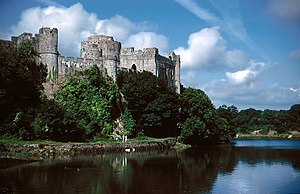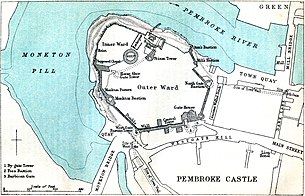
Pembroke Castle is a medieval castle in the centre of Pembroke, Pembrokeshire in Wales. The castle was the original family seat of the Earldom of Pembroke. A Grade I listed building since 1951, it underwent major restoration during the early 20th century.

Sir John Boys is best known as the Royalist Governor of Donnington Castle in Berkshire during the English Civil War.

The Second English Civil War took place between February and August 1648 in England and Wales. It forms part of the series of conflicts known collectively as the 1639–1653 Wars of the Three Kingdoms, which include the 1641–1653 Irish Confederate Wars, the 1639–1640 Bishops' Wars, and the 1649–1653 Cromwellian conquest of Ireland.

The First English Civil War took place in England and Wales from 1642 to 1646, and forms part of the 1639 to 1653 Wars of the Three Kingdoms. An estimated 15% to 20% of adult males in England and Wales served in the military at some point between 1639 and 1653, while around 4% of the total population died from war-related causes. These figures illustrate the widespread impact of the conflict on society, and the bitterness it engendered as a result.

Colonel Thomas Horton, January 1603 to October 1649, was a member of the minor gentry from Leicestershire who served in the Parliamentarian army during the Wars of the Three Kingdoms. Like many other of those who approved the Execution of Charles I in January 1649, Horton was a religious Independent. His family was closely connected to Sir Arthur Haselrig, one of the Five Members whose attempted arrest by Charles I in January 1642 was a major step on the road to the First English Civil War.

The Battle of Winceby took place on 11 October 1643 during the First English Civil War near the village of Winceby, Lincolnshire. In the battle, a Royalist relieving force under the command of Sir William Widdrington was defeated by the Parliamentarian cavalry of the Earl of Manchester.

The Battle of St Fagans took place on 8 May 1648 near St Fagans in South Glamorgan, during the Second English Civil War. A detachment from the veteran Parliamentarian New Model Army defeated a Royalist force primarily composed of mutinous former Parliamentarian soldiers, and ill-equipped levies. Their defeat ended significant Royalist resistance in Wales.

Major General Rowland Laugharne was a member of the Welsh gentry, and a prominent soldier during the Wars of the Three Kingdoms, in which he fought on both sides.

Richard Vaughan, 2nd Earl of Carbery KB, PC, styled The Honourable from 1621 to 1628 and then Lord Vaughan until 1634, was a Welsh soldier, peer and politician.
Events from the year 1648 in England. The Second English Civil War begins.
John Poyer was a Welsh soldier in the Parliamentary army during the English Civil War in South Wales. He later turned against the parliamentary cause and was executed for treason.
Sir Trevor Williams, 1st Baronet of Llangibby, Monmouthshire, was a Welsh gentry landowner and politician who sat in the House of Commons at various times between 1660 and 1692. He played a significant part in events during and after the English Civil War in South Wales, siding first with King Charles, then with the Parliamentarians, before rejoining the Royalists in 1648.
Rice Powell was a Welsh Colonel in the Parliamentary army during the First English Civil War. In the Second English Civil War he allied himself with the Royalist cause. He fought in South Wales and played a significant part in events between 1642 and 1649 including a senior role during the Battle of St. Fagans.
1644 was the third year of the First English Civil War. The King's position continued to decline and the Long Parliament sent the Propositions of Uxbridge, an attempt to end the war, to the king at Oxford
1645 was the fourth year of the First English Civil War. By the beginning of 1645 the war was going badly for Charles I and the campaigns of 1645 did not see a recovery in his prospects.

Worcestershire was the county where the first battle and last battle of the English Civil War took place. The first battle, the Battle of Powick Bridge, fought on 23 September 1642, was a cavalry skirmish and a victory for the Royalists (Cavaliers). The final battle, the battle of Worcester, fought on 3 September 1651, was decisive and ended the war with a Parliamentary (Roundhead) victory and King Charles II a wanted fugitive.

Tenby Castle was a fortification standing on a headland separated by an isthmus from the town of Tenby, Pembrokeshire, Wales. The remaining stone structure dates from the 13th century but there are mentions of the castle from as early as 1153. It is a Grade II* listed building.

The siege of Lincoln took place from 3 to 6 May 1644 during the First English Civil War, when the important town of Lincoln was besieged by Parliamentarian forces under the Earl of Manchester. On the first day, the Parliamentarians took the lower town. The Royalist defenders retreated into the stronger fortifications of the upper town, which encompassed and incorporated Lincoln Castle and Lincoln Cathedral. The siege ended four days later when the Parliamentarian soldiers stormed the castle, taking prisoner the Royalist governor, Sir Francis Fane, and what remained of his garrison.
The Second Siege of Bristol of the First English Civil War lasted from 23 August 1645 until 10 September 1645, when the Royalist commander Prince Rupert surrendered the city that he had captured from the Parliamentarians on 26 July 1643. The commander of the Parliamentarian New Model Army forces besieging Bristol was Lord Fairfax.

The Battle of Y Dalar Hir took place on 5 June 1648 in Caernarfonshire, North Wales, during the Second English Civil War. While little more than a skirmish, it had a significant effect on the local progress of the conflict.














